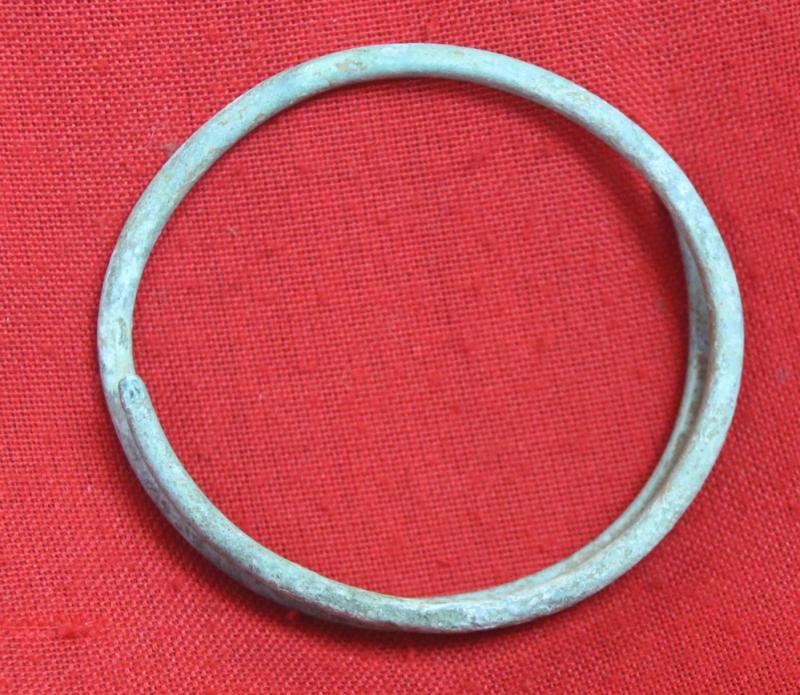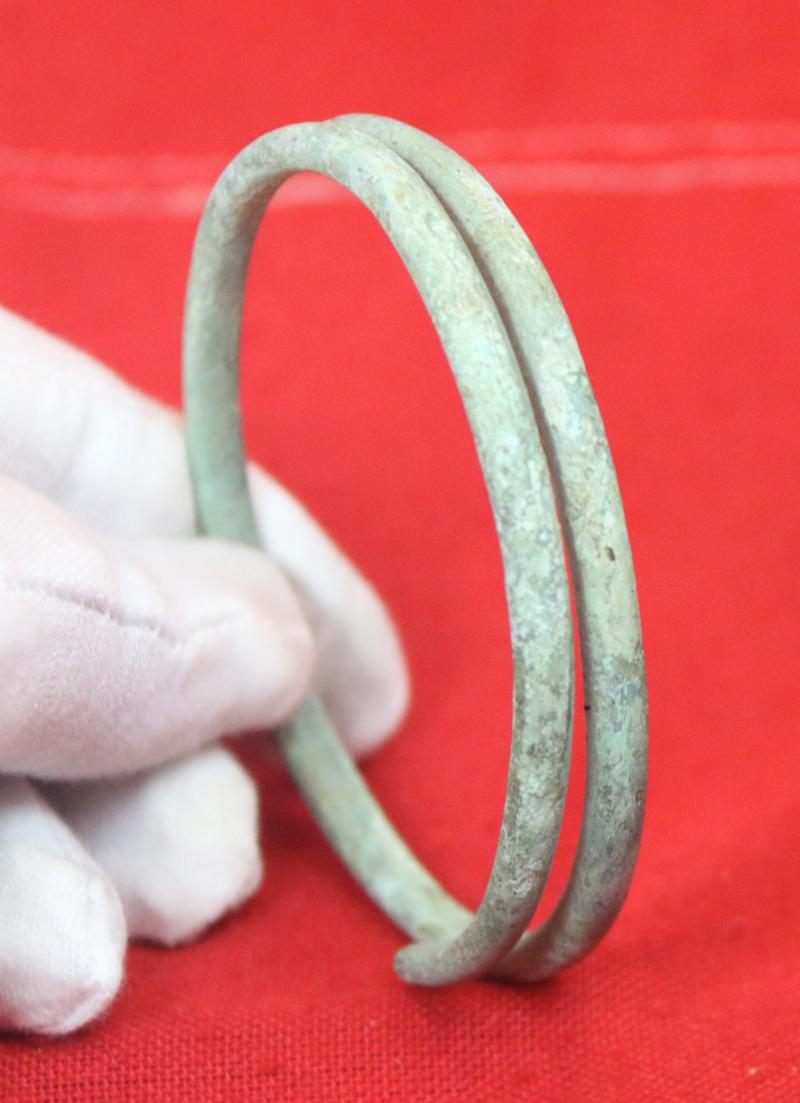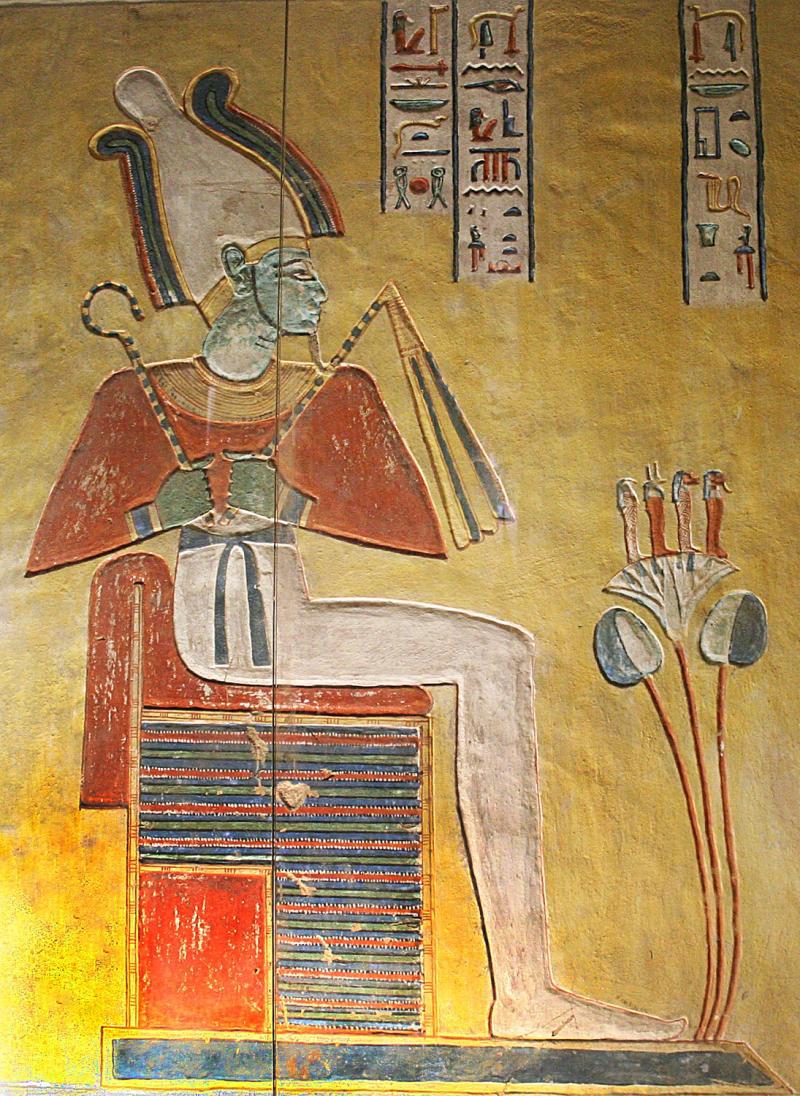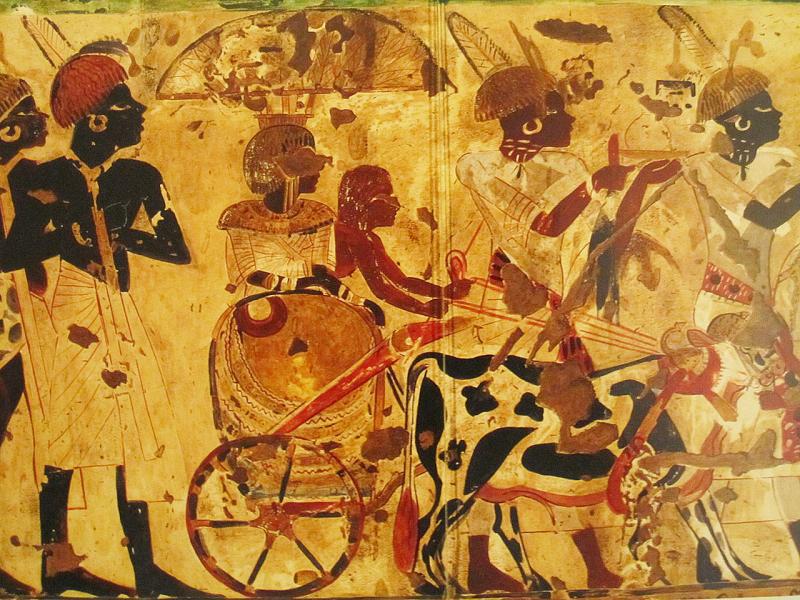A Most Fabulous, Large, Ancient Bronze Coiled Serpent Armilla or Armlet Arm Ring, From The 2nd Millenium B.C., From the Eras of the Pharoahs Ahmenhotep To Tutankhamun
One of two we acquired from an ancient antiquity collection, not quite a pair but very similar from the same period and country of origin, and we are offering them separately, but they were in fact often worn with one on each arm and may indeed came from the same tomb etc. 200 years or so ago. This example has a small pattern of indents at both ends, to appear like serpent's heads.
Over 3,300 to 3500 Years Old, 18th dynasty ancient Egyptian period, that includes Pharoah Ahmenhotep, Queen Nefertari, the most venerated Queen in Egyptian history, Pharoah Thutmose III, who became known as the greatest military pharaoh ever, and the most famous Pharoah in history, Tutankhamun.
A bronze serpent armilla arm ring that could be worn at the top of the arm or on the forearm, as it was adjustable in its day, expanding to the size required.
Worn by ancient Egyptian men or women of status, and we show pictures of original tomb art depicting figures of Egyptian dieties such as Osiris, almost all wearing armillae, but in their case likely made of gold, but the bronze type such as this would be polished bright and appear as gold as well.
Arm decoration and ornamentation was a very important sign of status and position in Ancient Egyptian society, and as it did in all the empires that followed over the next two thousand years. An intricate gold armlet from the artifacts of Nubian Queen Amanishakheto is displayed in the State Museum of Egyptian Art, in Munich, Germany. The armlet features a gold winged goddess. Another beautiful gold armlet is exhibited in Cairo Museum bearing the name of the pharaoh, Ahmose I, founder of the 18th Dynasty. The ancient Greeks and Romans also wore armlets, which were usually made from bronze or gold, and some of which were in the shape of serpents, winding plants, or embellished with images of gods and goddesses. Large, heavy armlets had hoops on the backs that attached to garments to help support their weight.
The Ancient Egyptian Dynasty XVIII was founded by Pharoah Ahmose I, the brother or son of Kamose, the last ruler of the 17th Dynasty. Ahmose finished the campaign to expel the Hyksos rulers. His reign is seen as the end of the Second Intermediate Period and the start of the New Kingdom. Ahmose's consort, Queen Ahmose-Nefertari was "arguably the most venerated woman in Egyptian history, and the grandmother of the 18th Dynasty." She was deified after she died. Ahmose was succeeded by his son, Amenhotep I, whose reign was relatively uneventful.
Amenhotep I probably left no male heir and the next pharaoh, Thutmose I, seems to have been related to the royal family through marriage. During his reign, the borders of Egypt's empire reached their greatest expanse, extending in the north to Carchemish on the Euphrates and in the south up to Kurgus beyond the fourth cataract of the Nile. Thutmose I was succeeded by Thutmose II and his queen, Hatshepsut, who was the daughter of Thutmose I. After her husband's death and a period of regency for her minor stepson (who would later become pharaoh as Thutmose III) Hatshepsut became pharaoh in her own right and ruled for over twenty years.
Thutmose III, who became known as the greatest military pharaoh ever, also had a lengthy reign after becoming pharaoh. He had a second co-regency in his old age with his son Amenhotep II. Amenhotep II was succeeded by Thutmose IV, who in his turn was followed by his son Amenhotep III, whose reign is seen as a high point in this dynasty.
Amenhotep III's reign was a period of unprecedented prosperity, artistic splendour, and international power, as attested by over 250 statues (more than any other pharaoh) and 200 large stone scarabs discovered from Syria to Nubia, Amenhotep III undertook large scale building programmes, the extent of which can only be compared with those of the much longer reign of Ramesses II during Dynasty XIX. Amenhotep III's consort was the Great Royal Wife Tiye, for whom he built an artificial lake, as described on eleven scarabs.
Akhenaten, the Amarna Period, and Tutankhamun
Akhenaten and his family adoring the Aten. Second from the left is Meritaten, daughter of Akhenaten.
Amenhotep III may have shared the throne for up to twelve years with his son Amenhotep IV. There is much debate about this proposed co-regency, with different experts considering that there was a lengthy co-regency, a short one, or none at all.
In the fifth year of his reign, Amenhotep IV changed his name to Akhenaten and moved his capital to Amarna, which he named Akhetaten. During the reign of Akhenaten, the Aten became, first, the most prominent deity, and eventually came to be considered the only god. Whether this amounted to true monotheism continues to be the subject of debate within the academic community. Some state that Akhenaten created a monotheism, while others point out that he merely suppressed a dominant solar cult by the assertion of another, while he never completely abandoned several other traditional deities.
Later Egyptians considered this "Amarna Period" an unfortunate aberration. After his death, Akhenaten was succeeded by two short-lived pharaohs, Smenkhkare and Neferneferuaten, of which little is known. In 1334 Akhenaten's son, Tutankhaten, ascended to the throne: shortly after, he restored Egyptian polytheist cult and subsequently changed his name in Tutankhamun, in honour to the Egyptian god Amun. His infant daughters, represent the final genetically related generation of the Eighteenth Dynasty
Ancient Egyptian art shows both men and women wearing pairs of armlets.
The 10th Duke of Hamilton had a strong interest in Ancient Egyptian mummies, and was so impressed with the work of mummy expert Thomas Pettigrew that he arranged for Pettigrew to mummify him after his death. He died on 18 August 1852 at age 84 at 12 Portman Square, London, England and was buried on 4 September 1852 at Hamilton Palace, Hamilton, Scotland. In accordance with his wishes, Hamilton's body was mummified after his death and placed in a sarcophagus of the Ptolemaic period that he had originally acquired in Paris in 1836 ostensibly for the British Museum. We have been acquiring similar such items from Duke's descendants from the family's 'Grand Tour' collection for the past 30 years or more.
82mm across at its widest point.
Code: 24880
1185.00 GBP









